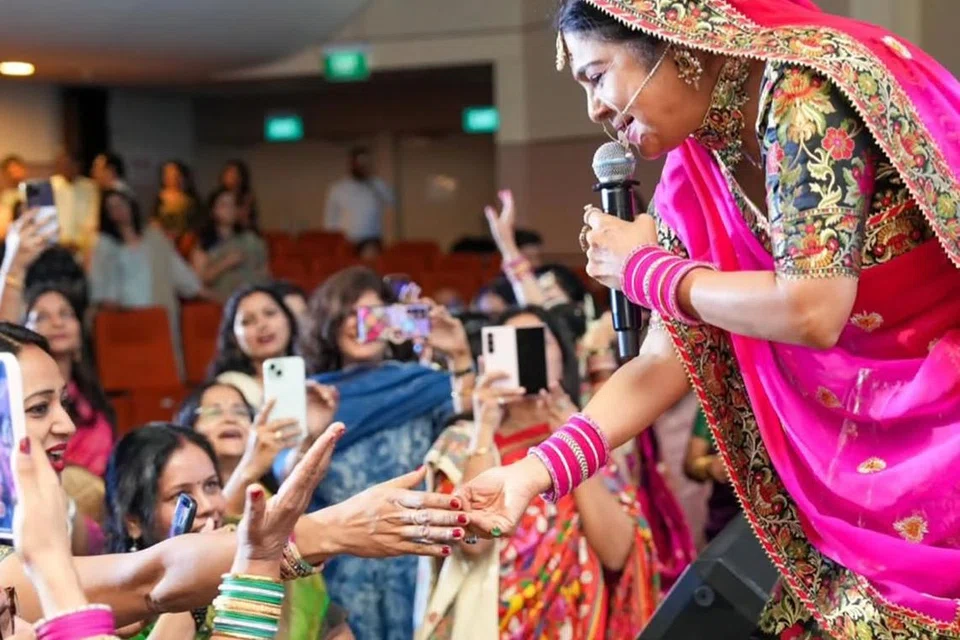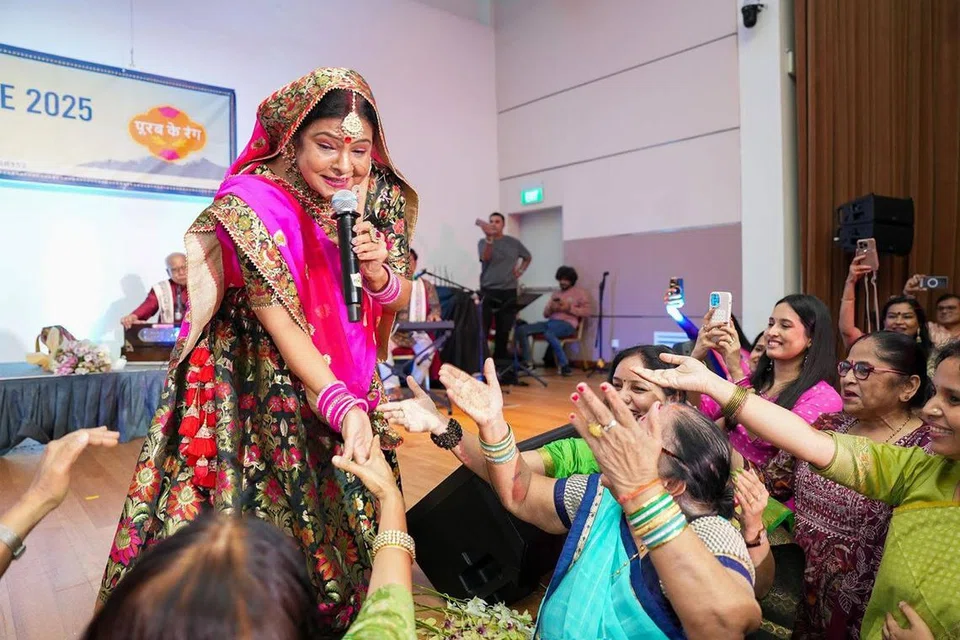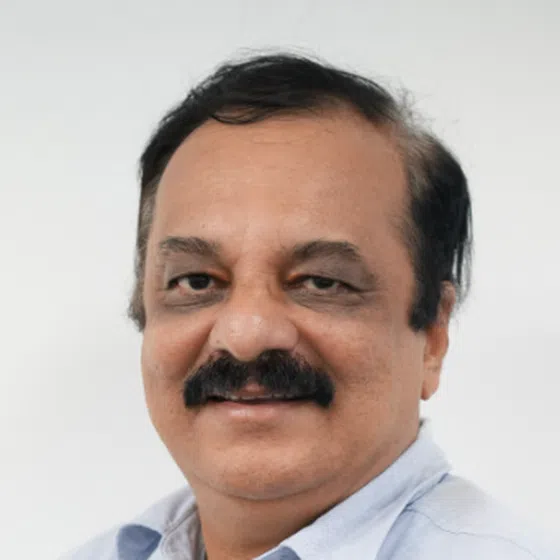Malini’s songs are people’s stories
The RELC Auditorium at Orange Grove Road was charged with energy on Aug 23 evening as Malini Awasthi, India’s iconic folk singer, took the stage for Purab ke Rang at the BiJhar Cultural Confluence 2025.
Before a packed house of 350, she sang her way into the hearts of the audience, earning a standing ovation that underscored the timeless appeal of Indian folk traditions.
The evening, presented by BiJhar (Singapore), was more than a concert; it was a celebration of Bihar and Jharkhand’s cultural heritage. With music, visual art, artefacts, and food all woven into the event, the spotlight belonged firmly to Malini.
From the very first note, Malini’s voice transported the audience to the heartlands of India. Songs in Awadhi, Bhojpuri, and Bundeli filled the auditorium with echoes of ancestral wisdom, of harvests and weddings, of joys and sorrows.
Her ability to converse with the audience and explain the origins and meanings of each song, made the experience deeply personal. At one point, an elderly woman in the crowd stood up in tears, saying: “You were singing my agony. You were telling my story.”
By the end of her two-hour set, the audience was on its feet, clapping and cheering in unison. It was a reaffirmation that folk music, far from being outdated, continues to hold emotional power even in the heart of cosmopolitan Singapore.
In an exclusive conversation, Malini reflected on why she has devoted her life to folk traditions.
“People often assume folk music is obsolete,” she explained. “But these songs are not just melodies – they are lived experiences of our ancestors, woven into verse. They speak of family, of community, of harmony with nature. At a time when modern life feels fragmented and individualistic, folk reminds us of oneness.”
She dismissed the Western notion of folk as “music of the uneducated masses”, stressing instead that in India, lok parampara (folk traditions) embrace everything around us: trees, rivers, animals, and human relationships.
“Even quantum physics now tells us everything is interconnected – and our forefathers already knew this. Folk songs are reminders of that truth,” she said.
Malini’s journey hasn’t been easy. In the 1980s, when she began, folk songs were dismissed as “songs grandmothers sang at home”. Few believed they could hold an audience for hours on stage.
She persisted, blending her classical training under Girija Devi of the Banaras gharana with her love of folk, and developed a unique conversational style.
Between verses, she would explain a song’s meaning, weaving in stories that helped urban and international audiences connect with dialects they might not understand.
“When people realised I wasn’t just singing, I was telling their stories – of love, loss, migration, seasons – they connected,” she recalled. “That empathy changed everything.”
Over four decades, Malaini has unearthed and revived thousands of songs – some passed down in family diaries, some taught by gurus, others discovered through villagers and fans who reached out to her on social media.

Her repertoire spans kajri, chaiti, sohar, dadra, and jhula, each rooted in local rituals and life cycles.
One moving example she cited was of a bride leaving home who pleads with her father not to cut a neem tree she grew up with – a song that is as much about memory as it is about ecology.
“These are songs of dignity, empathy, and harmony,” she said. “In today’s world, where people have everything but still lack peace, these songs offer balance.”
Though deeply rooted in India’s soil, Malini’s music has reached audiences across the world – from Spain and South Korea to the United States. She adapts not by changing the songs but by framing them for foreign audiences.
“Sometimes I use an interpreter, sometimes I explain in English,” she said. “But emotions of longing, of love, of family – these are universal. People feel them everywhere.”
Her recent collaboration for Coke Studio Bharat – Holi Aye Re with Vishal Mishra – broke into Spotify’s Global Top 100, a first for Indian folk. “It shows that authenticity resonates,” she said.
Beyond performance, Malini is focused on transmission. Through her non-profit Sonchiraiya, founded in 2011, she organises workshops on folk forms like kajri and wedding songs, introducing younger generations to traditions often thought lost.
“An art survives only if new energy joins it,” she said. “I see young women now – even married women – taking up folk as a career. That gives me hope.”
She also uses technology to connect with youth. “If the younger generation is on Instagram and YouTube, then folk music must be there too. That’s how songs buried for years are making a comeback.”
Born in Kannauj, a city in Uttar Pradesh, and raised in Lucknow in a family of doctors, Malini discovered music early. Encouraged by her mother, she trained in classical music before gravitating to folk. Marriage and family slowed her pace briefly, but she never stopped singing.
Balancing career and home was challenging, she admitted: “As a woman, you give 100 per cent to family and 100 per cent to career. It has to be 200 per cent. Nothing can be ignored.”
Her family – a bureaucrat husband, a daughter who is a doctor and writer, and a son who is a lawyer – remain deeply supportive. “Music unites us all,” she said with a smile.
Malini believes the world is on the cusp of a cultural revival. “People want to rediscover their roots. They want to know what rituals mean, why songs were sung. Social media, surprisingly, is helping this renaissance.”
After four decades, she sees her mission as partly fulfilled: “If I have contributed even one per cent to restoring respect for folk, I feel blessed.”
At Bijhar Cultural Confluence 2025, as the final notes faded and the audience rose to their feet, it was clear that Malini’s songs still carry the heartbeat of India – not locked in the past, but alive, relevant, and needed.
Her performance wasn’t just music. It was memory, wisdom, and tradition – lovingly preserved and powerfully shared.
As she reminded the Singapore crowd: “Folk is not about me, it is about us. It is our oneness, our heritage. And as long as we sing, it will live.”


